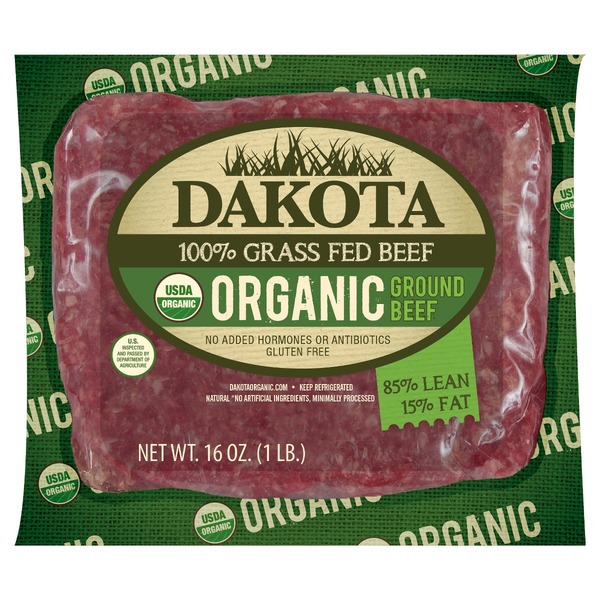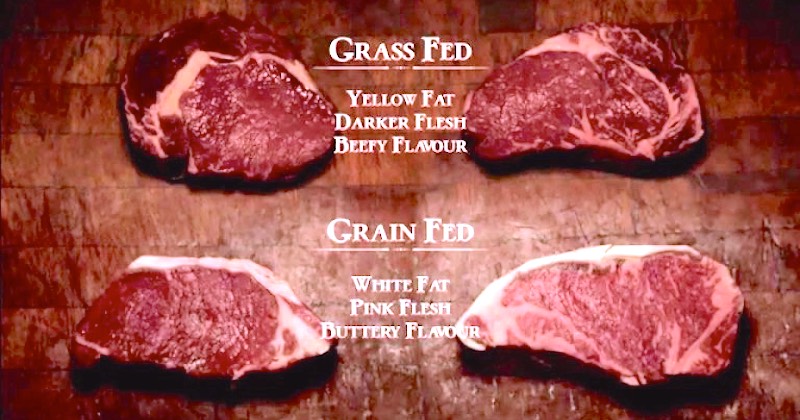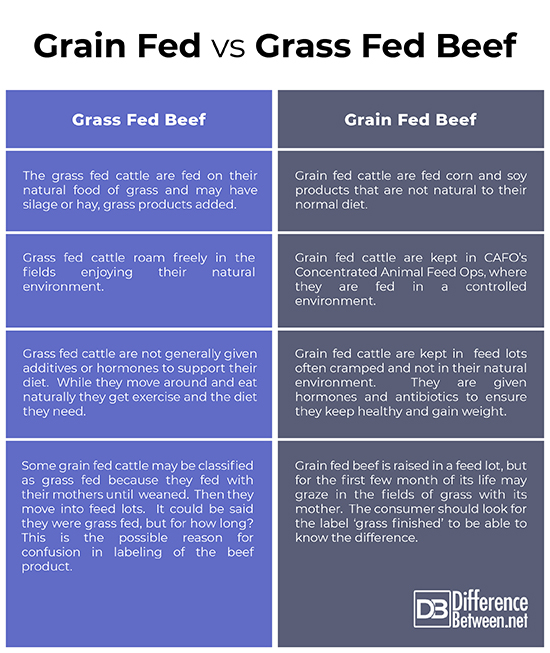Difference between Grass Fed Beef and Grain Fed Beef
Grass feeding, or feeding grain in feed lots, are two different ways that beef cattle can be raised. Feeding cattle differently produces differences in the quality of the meat and the living conditions of the animals. Grass fed cattle keep more closely to their natural habitat, while grain fed cattle are on controlled beef management programs, using grain and soy cattle feed. The end product is an animal ready for the beef industry. How they get to this point is what makes the difference. It is important to check labels and information provided by the butcher to confirm the origins of the meat. The quality of life of the grass fed animal is closer to their natural environment, while the grain fed animal is likely to be in confined quarters being fattened purely for the market place.
The type of food fed to these animals affects the meat differently and the freedom of being able to enjoy a grass fed environment puts less stress on the grass fed animal. The margin of confusion comes with calves receiving a grass fed start to life. After they are weaned they may become one of the lot feed animals. There is a good chance that these animals may be classed as grass fed because they started out that way. However, consumers should check the label and see if the grass fed option was carried through to adulthood. The term ‘grass finished’ would confirm the cow was grass fed throughout its life till ready for the market.

What is Grass Fed Beef?
Grass fed is the term used to describe the feeding program for grazing animals like beef cattle. These animals depend on grass for their nourishment and benefit from the lifestyle they live in order to be grass fed. Grazing in fields is as close to their natural habitat as they can get. The outcome is that grass fed cattle produce leaner meat. In making a comparison gram for gram grass fed beef has less calories. The meat composition differs too. Grass fed and grain fed meats contain a similar amount of omega 6, but the omega 3 content of the meat is five times higher in grass fed beef. Added to that, grass fed beef has twice as much conjugated linoleic acid or CLA, than grain fed meat. Omega 3, CLA and fatty acids are all linked to health benefits. Grass fed beef is more nutritious and healthy.
What are the Benefits of Grass Fed Animals?
- Grass fed beef is more nutritious and less fattening. The animals are fed on their natural food in their natural environment.
- Grass fed beef is higher in vitamin content and contains vitamin A, vitamin E, betacarotine and antioxidants.
- Grass fed beef is leaner and has a different texture to grain fed beef.
- Grass fed animals are allowed to roam freely in grassy fields and suffer less stress as they feed on their natural food, grass.

What is Grain Fed Beef?
Grain fed beef is the method used to produce beef by feeding the cows in feeding programs in feed lots. They are fed on corn and soy products. This is not their natural diet. The young calves may start out in the fields eating grass with their mothers, until they are weaned. At this point they are moved into feed lots and fed a controlled diet. They are also given hormones to increase their weight, as well as antibiotics to prevent any diseases. Many feed lots are cramped and the conditions are stressful for the animals. The main focus of their lively hood is to produce a good fat cow for the market. The majority of beef cattle raised in America are grain fed, while Australia, another beef producing country, produces mostly grass fed cattle. The grain fed cattle are given growth hormones to increase their weight gain and get them ready to be slaughtered. This is a scientific approach to raising the biggest, best beef the fastest way possible.
What are the Benefits of Grain Fed?
- Grain fed beef is more readily available and in the market place and is a more affordable option.
- Grain fed differs in the nutrients it has to offer, but there is no evidence to conclude that one form of beef is more healthy than the other.
- Grain fed beef is a manageable farming choice if farmers are looking to mass produce beef and beef products.
- Grain fed beef contains 4x more fat per 3oz serving than grass fed beef and therefore it is higher in omega 6. Grain fed beef is used extensively in ground beef mince and 40% of the American beef intake is made up of ground beef.
Differences in Grain Fed or Grass Fed Beef
-
Raising Calves:
Both grain fed and grass fed calves are raised with their mothers until they are weaned at about seven to nine months. At this stage the grain fed calves are put into feed lots and their diet becomes made of corn and soy products. Grass fed calves continue to live in pastures and feed on grass.
-
Housing and Shelter:
Grass fed cows spend their day out in the open on grassy fields. They are protected in secure areas at night. Grain fed cattle are housed in feed lots where their food and water and shelter is controlled. They are not free to roan and graze their own food.
-
Costs and Methods in Grain Fed and Grass Fed Beef
Both types of feeding techniques incur costs however, grain feeding has the added cost of hormones to increase the growth of the animal and antibiotics to keep it healthy
-
Advantages and Disadvantages in Grain Fed and Grass Fed Beef
The obvious advantage of a grass fed animal is it is healthier living in it’s natural environment and suffers less stress during the time it is fattened ready for the beef industry. The disadvantage is that it is not always practical to find large grass feed pastures and meet the demand of the beef industry. The business of farming makes demands on the beef farmer to produce enough beef to supply the market place, however, the animals raised in these conditions are not in their natural environment and strict control needs to be taken to ensure animals are not mistreated unnecessarily.
Grain Fed Beef verses Grass Fed Beef

Summary:
- Beef that is grass fed is seen to be more nutritious and a better option if it is available..
- Grass fed cattle are under less stress during their life time and this affects the quality of the meat.
- Although there is no proof that grass fed beef is more nutritious it would appear that a grass fed animal has less fat and would be a better option for the consumer. Grain fed beef is a cheaper option but contains more fat.
- Beef that is grain fed will be carrying added growth hormones and antibiotics that have been fed to the animals to keep them healthy and fatten them quicker.
- The consumer who wants to have a grass fed beef experience should check labels carefully to ensure the beef is grass fed. It is not always possible to purchase grass fed beef, but being aware of what it takes to produce grass fed animals and how they differ from grain fed animals will be helpful to the discerning beef eater.
- Difference Between Lagoon and Bay - October 20, 2021
- Difference Between Futurism and Preterism - August 12, 2021
- Difference Between Dichotomy and Paradox - August 7, 2021
Search DifferenceBetween.net :
1 Comment
Leave a Response
References :
[0]Smith Stephen. Grain fed vs grass fed ground beef. March 25 2014. www.beefmagazine.com pub. Farm progress Informa USA. Reviewed 2/12/2018.
[1]Gunners Chris BSC May 17th 2018. grass fed vs grain fed. Www.healthline.com/newsletter/nutrician/grass fed vs grain fed beef. Reviewed 2/12/2018
[2]Joseph Michael. Grass fed / grain fed. August 31 2018 www.nutricianadvance.com/is-grass-fed-beef-necessary. Reviewed 3/12/2018
[3]Image credit: http://www.froggyandthemouse.com/wp-content/uploads/2018/01/grass-grain-fed-beef.jpg
[4]Image credit: https://d2lnr5mha7bycj.cloudfront.net/product-image/file/large_2c7d0464-23bc-4894-b231-d02203d8d42a.jpeg

Is there a difference in taste and/or texture between grass fed and grain fed?